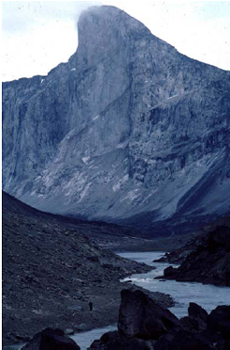|
Ice sheets and glaciers are sensitive indicators of climate change over time. We have used cosmogenic nuclides to elucidate the history of now-vanished glacial ice in a variety of locations.
In the Canadian arctic, we have worked to understand the dynamics of ice caps that appear to have been wet and warm-based in deep fiords while frozen to their beds over much of the uplands. This behavior led to the preservation of highly weathered rock even though it was overridden by ice. In the mid-continent, we have used cosmogenic dating to suggest that even large continental ice sheets were ineffective eroders near their margin where they too may have been frozen to the bed or very thin. On New England's highest peaks we find a similar story of cold ice, unable too effectively erode rock. In contrast, work we have done in the Rocky Mountains suggests large sediment fluxes from warm-based mountain glaciers shaped river drainages downstream.
This research has been supported by the NSF.
Relevant Publications:
- Colgan, P.M., Bierman, P. R., Mickelson, D. M., and Caffee, M. W. (2002) Variation in glacial erosion near the southern margin of the Laurentide Ice Sheet, south central Wisconsin, USA: implications for cosmogenic dating of glacial terrains. Geological Society of America Bulletin, v. 114, no. 12, p. 1581-1591.
- Davis, P.T., Bierman, P.R., Marsella, K.A., Caffee, M.W., and Southon, J.R., (1999) Cosmogenic analysis of glacial terrains in the eastern Canadian Arctic: a test for inherited nuclides and the effectiveness of glacial erosion. Annals of Glaciology. 28, p. 181-188.
- Bierman, P. R., Marsella, K. A., Davis, P. T., Patterson, C. and Caffee, M., (1999), Mid-Pleistocene cosmogenic minimum-age limits for pre-Wisconsinan glacial surfaces in southwestern Minnesota and southern Baffin Island -- a multiple nuclide approach. Geomorphology, 27, n 1 / 2, p. 25-40 and subsequent comment and reply Geomorphology (2001), 39, n. 3–4, p. 255-261.
- Briner, J.P., Miller, G.H., Davis, P.T., Caffee, M., Bierman, P., and Finkel, R. (2003) Last Glacial Maximum erratics perched on ancient tors in Arctic Canada: Implications for ice sheet dynamics. Quaternary Science Reviews. v. 22, p. 437-444
- Schildgen, T., Dethier, D., Bierman, P.R., and Caffee, M. (2002) 26Al and 10Be dating of late Pleistocene and Holocene fill terraces: a record of glacial and non-glacial fluvial deposition and incision, Colorado Front Range, Earth Surface Processes and Landforms, 27, 773-787.
- Marsella, K., Bierman, P. R., Davis, T., and Caffee, M. (2000) Deglacial dynamics and timing, Pangnirtung Fjord and Kolik Valley, Baffin Island, Canada. Geological Society of America Bulletin, v.112, p. 1296-1312.
- Bierman, P.R., Davis, P.T., and Caffee, M. W. (2000) Old surfaces on New England summits imply thin Laurentide ice, Geological Society of America Abstracts with Programs, 31 (7), A-330. (National)
|




